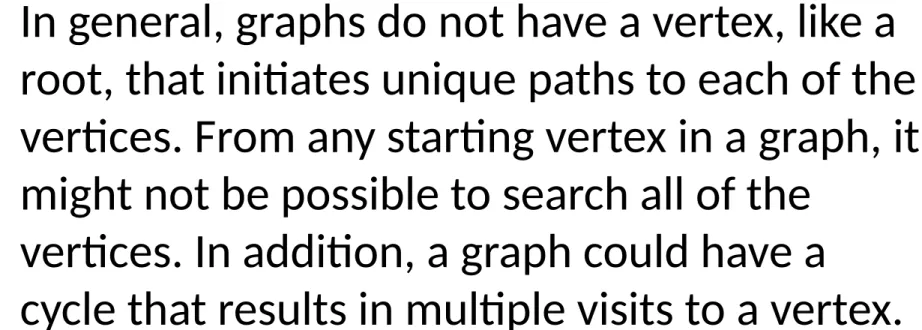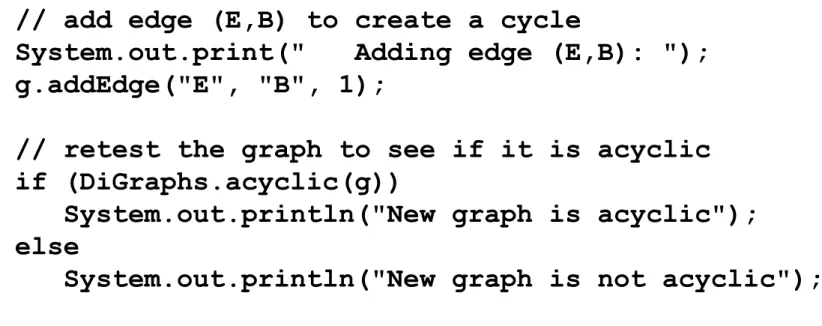Algoritma Traversal Graph
Graph Traversal Algorithms
• In general, graphs do not have a vertex, like a root, that initiates unique paths to each of the vertices. From any starting vertex in a graph, it might not be possible to search all of the
vertices. In addition, a graph could have a
cycle that results in multiple visits to a vertex.
Graph Traversal Algorithms (continued)
• The breadth-first search visits vertices in the order of their path length from a starting
vertex. It may not visit every vertex of the graph
• The depth-first search traverses all the vertices of a graph by making a series of recursive calls that follow paths through the graph.
© 2005 Pearson Education, Inc., Upper Saddle River, NJ. All rights reserved.
Graph Traversal Algorithms (continued)
• Graph algorithms discern the state of a vertex during the algorithm by using the colors
WHITE, GRAY, and BLACK.
Breadth-First Search Algorithm
© 2005 Pearson Education, Inc., Upper Saddle River, NJ. All rights reserved.
Breadth-First Search Algorithm (continued)
• Color all vertices of the sample graph WHITE
and push the starting vertex (A) onto the queue visitQueue.
• Pop A from the queue, color it BLACK, and
insert it into visitList, which is the list of visited vertices. Push all WHITE neighbors onto the
queue.
Breadth-First Search Algorithm (continued)
• Pop B from the queue and place it in visitList with color BLACK. The only adjacent vertex for B is D, which is still colored WHITE. Color D
GRAY and add it to the queue
© 2005 Pearson Education, Inc., Upper Saddle River, NJ. All rights reserved.
Breadth-First Search Algorithm (continued)
• Pop C and place it in visitList. The adjacent
vertex G is GRAY. No new vertices enter the
queue.
Breadth-First Search Algorithm (continued)
• Pop vertex G from the queue and place it in visitList. G has no adjacent vertices, so pop D from the queue. The neighbors, E and F, enter the queue.
© 2005 Pearson Education, Inc., Upper Saddle River, NJ. All rights reserved.
Breadth-First Search Algorithm (continued)
• Continue in this fashion until the queue is
empty.
Implementing Breadth-First Search
• Define
© 2005 Pearson Education, Inc., Upper Saddle River, NJ. All rights reserved.
public enum VertexColor {
WHITE, GRAY, BLACK }
Implementing Breadth-First Search (continued)
• The DiGraph class declares three methods that access and update the color attribute of a
vertex.
Implementing Breadth-First Search (continued)
• The method bfs() returns a list of vertices
visited during the breadth first search from a ‑ starting vertex.
© 2005 Pearson Education, Inc., Upper Saddle River, NJ. All rights reserved.
bfs()
// perform the breadth-first traversal // from sVertex and return the list // of visited vertices
public static <T> LinkedList<T> bfs(
DiGraph<T> g, T sVertex) {
// queue stores adjacent vertices; list // stores visited vertices
LinkedQueue<T> visitQueue = new LinkedQueue<T>();
LinkedList<T> visitList = new LinkedList<T>();
// set and iterator retrieve and scan // neighbors of a vertex
Set<T> edgeSet;
Iterator<T> edgeIter;
T currVertex = null, neighborVertex = null;
© 2005 Pearson Education, Inc., Upper Saddle River, NJ. All rights reserved.
bfs() (continued)
// check that starting vertex is valid if (!g.containsVertex(sVertex))
throw new IllegalArgumentException(
"bfs(): starting vertex not in the graph");
// color all vertices WHITE g.colorWhite();
// initialize queue with starting vertex visitQueue.push(sVertex);
while (!visitQueue.isEmpty()) {
// remove a vertex from the queue, color // it black, and add to the list of
// visited vertices
currVertex = visitQueue.pop();
g.setColor(currVertex,VertexColor.BLACK);
visitList.add(currVertex);
bfs() (continued)
// obtain the set of neighbors for current vertex edgeSet = g.getNeighbors(currVertex);
// sequence through the neighbors and look // for vertices that have not been visited edgeIter = edgeSet.iterator();
while (edgeIter.hasNext()) {
neighborVertex = edgeIter.next();
© 2005 Pearson Education, Inc., Upper Saddle River, NJ. All rights reserved.
bfs() (concluded)
if (g.getColor(neighborVertex) ==
VertexColor.WHITE) {
// color unvisited vertex GRAY and // push it onto queue
g.setColor(neighborVertex,VertexColor.GRAY);
visitQueue.push(neighborVertex);
} } }
return visitList;
}
bfs() (concluded)
if (g.getColor(neighborVertex) ==
VertexColor.WHITE) {
// color unvisited vertex GRAY and // push it onto queue
g.setColor(neighborVertex,VertexColor.GRAY);
visitQueue.push(neighborVertex);
} } }
return visitList;
}
Running Time of Breadth-First Search
• The running time for the breadth-first search is O(V + E), where V is the number of vertices and E is the number of edges.
© 2005 Pearson Education, Inc., Upper Saddle River, NJ. All rights reserved.
Breadth-First Search Example
// create a graph g and declare startVertex and visitList DiGraph<String> g = DiGraph.readGraph("bfsgraph.dat");
String startVertex;
List<String> visitList;
...
// call bfs() with arguments g and startVertx visitList = DiGraphs.bfs(g, startVertex);
Breadth-First Search Example (concluded)
© 2005 Pearson Education, Inc., Upper Saddle River, NJ. All rights reserved.
Output:
Run 1: (startVertex = "A")
BFS visitList from A: [A, G, B, C, D, E, F]
Run 2: (startVertex = "D")
BFS visitList from D: [D, E, F, G]
Run 3: (startVertex = "E")
BFS visitList from E: [E]
Depth-First Visit
• The depth-first visit algorithm is modeled after the recursive postorder scan of a binary tree.
In the tree, a node is visited only after visits
are made to all of the nodes in its subtree. In
the graph, a node is visited only after visiting
all of the nodes in paths that emanate from
the node.
Depth-First Visit (continued)
• Backtrack to the previous recursive step and look for another adjacent vertex and launch a scan down its paths. There is no ordering
among vertices in an adjacency list, so the
paths and hence the order of visits to vertices can vary.
© 2005 Pearson Education, Inc., Upper Saddle River, NJ. All rights reserved.
Depth-First Visit (continued)
• Discover A (color GRAY)
• Discover B (color GRAY)
• Discover D (color GRAY)
• Discover E (color GRAY, then BLACK)
• Backtrack D (color BLACK)
• Backtrack B (color BLACK)
• Backtrack A (A remains GRAY)
• Discover C (color BLACK)
• Backtrack A (color BLACK). Visit complete.
Depth-First Visit (continued)
• The depth first visit is a recursive algorithm ‑ that distinguishes the discovery and finishing time (when a vertex becomes BLACK) of a
vertex.
• The depth first visit returns a list of the ‑
vertices found in the reverse order of their finishing times.
© 2005 Pearson Education, Inc., Upper Saddle River, NJ. All rights reserved.
Depth-First Visit (continued)
• An edge that connects a vertex to a neighbor that has color GRAY is called a back edge.
– A depth-first visit has a cycle if and only if it has a
back edge.
© 2005 Pearson Education, Inc., Upper Saddle River, NJ. All rights reserved.
dfsVisit()
// depth-first visit assuming a WHITE starting
// vertex; dfsList contains the visited vertices in // reverse order of finishing time; when checkForCycle // is true, throws IllegalPathStateException if it
// detects a cycle
public static <T> void dfsVisit(DiGraph<T> g, T sVertex, LinkedList<T> dfsList, boolean checkForCycle)
{
T neighborVertex;
Set<T> edgeSet;
// iterator to scan the adjacency set of a vertex Iterator<T> edgeIter;
VertexColor color;
if (!g.containsVertex(sVertex))
throw new IllegalArgumentException(
"dfsVisit(): vertex not in the graph");
dfsVisit() (continued)
// color vertex GRAY to note its discovery g.setColor(sVertex, VertexColor.GRAY);
edgeSet = g.getNeighbors(sVertex);
// sequence through the adjacency set and look // for vertices that are not yet discovered
// (colored WHITE); recursively call dfsVisit()
// for each such vertex; if a vertex in the adjacency // list is GRAY, the vertex was discovered during a // previous call and there is a cycle that begins and // ends at the vertex; if checkForCycle is true,
// throw an exception
edgeIter = edgeSet.iterator();
© 2005 Pearson Education, Inc., Upper Saddle River, NJ. All rights reserved.
dfsVisit() (concluded)
while (edgeIter.hasNext()) {
neighborVertex = edgeIter.next();
color = g.getColor(neighborVertex);
if (color == VertexColor.WHITE)
dfsVisit(g, neighborVertex, dfsList, checkForCycle);
else if (color == VertexColor.GRAY && checkForCycle) throw new IllegalPathStateException(
"dfsVisit(): graph has a cycle");
}
// finished with vertex sVertex; make it BLACK // and add it to the front of dfsList
g.setColor(sVertex, VertexColor.BLACK);
dfsList.addFirst(sVertex);
}
Depth-First Visit Example
LinkedList<String> finishOrder = new LinkedList<String>();
g.colorWhite();
DiGraphs.dfsVisit(g, "B", finishOrder, false);
Output: finishOrder: [B, D, E, F, C]
Depth-First Visit Example (concluded)
© 2005 Pearson Education, Inc., Upper Saddle River, NJ. All rights reserved.
finishOrder = new LinkedList<String>();
g.colorWhite();
try {
DiGraphs.dfsVisit(g, "E", finishOrder, true);
System.out.println("finishOrder: " + finishOrder);
}
catch (IllegalPathStateException ipse) {
System.out.println(ipse.getMessage());
}
Output: dfsVisit(): cycle involving vertices D and E
Depth-First Search Algorithm
• Depth first search begins with all ‑
WHITE vertices and performs depth first visits ‑ until all vertices of the graph are BLACK.
• The algorithm returns a list of all vertices in the graph in the reverse order of their
finishing times.
© 2005 Pearson Education, Inc., Upper Saddle River, NJ. All rights reserved.
dfs()
// depth-first search; dfsList contains all // the graph vertices in the reverse order // of their finishing times
public static <T> void dfs(DiGraph<T> g, LinkedList<T> dfsList)
{
Iterator<T> graphIter;
T vertex = null;
// clear dfsList dfsList.clear();
// initialize all vertices to WHITE g.colorWhite();
dfs() (concluded)
// call dfsVisit() for each WHITE vertex graphIter = g.vertexSet().iterator();
while (graphIter.hasNext()) {
vertex = graphIter.next();
if (g.getColor(vertex) == VertexColor.WHITE) dfsVisit(g, vertex, dfsList, false);
} }
Running Time for Depth-First Search
• An argument similar to that for the breadth- first search shows that that the running time for dfs() is O(V+E), where V is the number of vertices in the graph and E is the number of edges.
© 2005 Pearson Education, Inc., Upper Saddle River, NJ. All rights reserved.
Depth-First Search Example
dfsVisit() starting at E followed by dfsVisit() starting at A dfsList: [A, B, C, E, F, G, D]
© 2005 Pearson Education, Inc., Upper Saddle River, NJ. All rights reserved.
Program 24.2
import java.io.FileNotFoundException;
import ds.util.DiGraph;
import ds.util.DiGraphs;
public class Program24_2 {
public static void main(String[] args) throws FileNotFoundException
{
DiGraph<String> g = DiGraph.readGraph("cycle.dat");
// determine if the graph is acyclic if (DiGraphs.acyclic(g))
System.out.println("Graph is acyclic");
else
System.out.println("Graph is not acyclic");
Program 24.2 (concluded)
// add edge (E,B) to create a cycle
System.out.print(" Adding edge (E,B): ");
g.addEdge("E", "B", 1);
// retest the graph to see if it is acyclic if (DiGraphs.acyclic(g))
System.out.println("New graph is acyclic");
else
System.out.println("New graph is not acyclic");
} } Run:
Graph is acyclic
Adding edge (E,B): New graph is not acyclic

